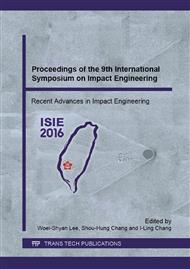p.101
p.107
p.111
p.116
p.122
p.128
p.133
p.139
p.147
Measuring Behavior of Impactor Penetrating through Polymer Sheet Based on Electromagnetic Induction
Abstract:
In the paper, the behavior of an impactor penetrating through a polymer sheet was measured using electromagnetic induction phenomena. First, electromotive forces generated in a coil were measured to decide the relation between the impactor velocity and the electromotive force when the impactor with an embedded neodymium magnet passed through a coil at several constant velocities. The intensity of the electromotive force was found to be proportional to the impactor velocity at each impactor position. The relation was used as the calibration data to calculate the velocity and position of the impactor. Next, penetration tests of polyvinyl chloride sheets were conducted with the coil set at the front of the sheet. The electromotive force generated in the coil was measured when the impactor penetrated through the sheet. The impactor velocity and position were calculated from the electromotive force with the calibration data. The validity of the measuring method was confirmed because the calculated results from the measured electromotive force agreed with the observed results by using a high speed video camera.
Info:
Periodical:
Pages:
122-127
Citation:
Online since:
September 2016
Authors:
Price:
Сopyright:
© 2016 Trans Tech Publications Ltd. All Rights Reserved
Share:
Citation:


